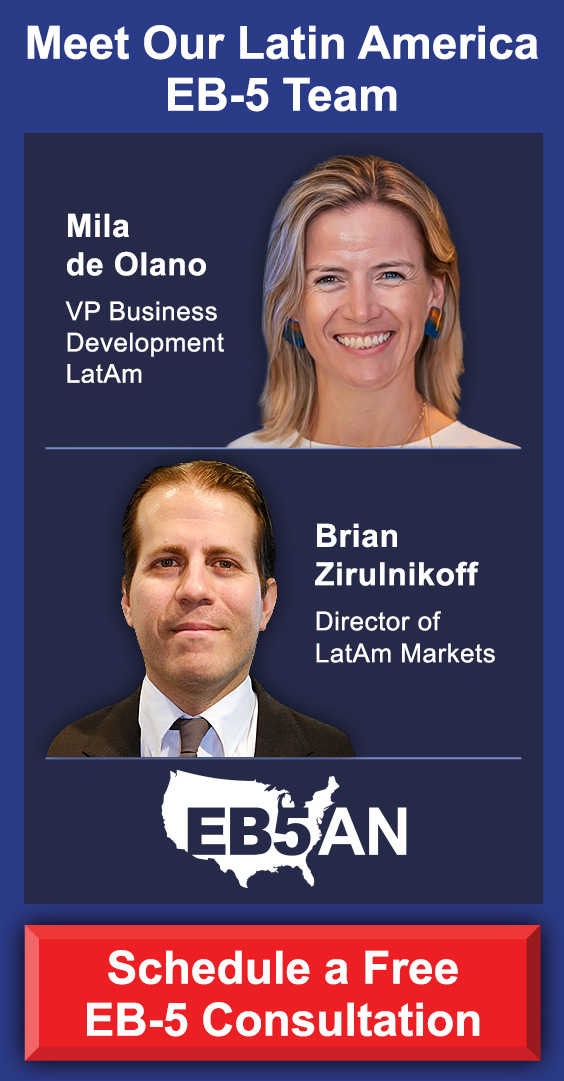As the agency in charge of operating the EB-5 Immigrant Investor Program, USCIS reviews each EB-5 petition in detail. Every cent of invested funds from EB-5 applicants is carefully vetted to ensure it was sourced legally and invested in compliance with EB-5 policies.
USCIS has set a high evidentiary standard for Form I-526E, the first petition in the EB-5 immigration process. The I-526E petition is used to prove that you have made a qualifying investment and that the funds were properly documented.
But if USCIS finds missing evidence or a lack of compliance in your I-526E submission, it may issue a request for evidence (RFE)—or simply deny your submission. An RFE—let alone a denial—can cause additional months of delays, significant additional expenses, and ultimately disqualify you and your family from U.S. Green Cards.
That’s why it’s crucial to make sure your EB-5 funds are properly sourced, documented, and invested before you submit Form I-526E.
One worrying trend in the industry is that some regional centers are offering to loan their EB-5 applicants all or part of the funds for their investments. The regional center may offer these loans through a “third-party” entity controlled by the regional centers’ principals.
These loan arrangements clearly violate the USCIS requirements stated above, easily leading to an RFE or I-526E denial. What is more, unscrupulous regional centers can use these “loans” to effectively recycle their own funds among their EB-5 projects—regardless that their EB-5 investors are in line for a USCIS denial and the probable loss of their funds.
These elaborate, Ponzi-like schemes may seem to offer a convenient loan that allows you to make a partial EB-5 investment and file Form I-526E quicky. But they significantly increase your risk of losing every cent of your investment and your immigration goals.
“It’s concerning to see regional centers offer loans to their EB-5 investors in a way that is forbidden by USCIS,” comments EB5AN managing partner Sam Silverman. “Besides disregarding USCIS policy, these EB-5 operators put their investors’ immigration and financial interests on the line only to gain quick access to capital.”
How can you identify and avoid these unethical loan arrangements as an EB-5 investor?
In this post, we explain in further detail how loans from regional centers to EB-5 investors violate USCIS requirements. We then discuss the warning signs you should consider before investing with an EB-5 regional center that offers you a loan.
Let’s begin by reviewing two key requirements for EB-5 funds.
Understanding the “At-Risk” and Source-of-Funds Requirements.
EB-5 Loans From Regional Centers Are Not Allowed; Avoid Losing Your Funds in a Ponzi-Like Scheme
Don’t Risk Losing Your Green Cards and Your Invested Funds
Understanding the “At-Risk” and Source-of-Funds Requirements.
The “At-Risk” Requirement
EB-5 investors first transfer their funds to an escrow account set up by their regional center’s investment funds. In the EB-5 program, this investment fund is known as a new commercial enterprise (NCE).
Upon release from escrow, the funds are then deployed from the NCE to the EB-5 project entity. The EB-5 project is known as a job-creating entity (JCE).
Within this process, the “at-risk” requirement ensures that investors’ capital is genuinely exposed to potential loss, rather than secured or guaranteed, for a minimum period (currently, two years from the “time of investment”). Investors must transfer and commit their funds to the NCE and accept both financial and immigration risks—with no contractual guarantee of return—to satisfy USCIS guidelines.
In other words, an investor’s funds must be actively used in an EB-5 project where there is a real possibility of losing some or all of the capital. As the USCIS Policy Manual states, “To qualify as an investment, the immigrant investor must actually place his or her capital at risk. The mere intent to invest is not sufficient.”
The Policy Manual adds that the “benefit is greatest when capital is at risk and invested in a new commercial enterprise that, because of the investment, creates at least 10 full-time jobs for U.S. workers.”
Therefore, EB-5 funds must be transferred to the EB-5 project with evidence—such as wire transfer confirmations and legal agreements—demonstrating that the capital is allocated toward job-creating activities.
The above clearly shows that EB-5 investors must invest their own funds. Regardless of the source of the EB-5 capital, the funds must be fully owned by the EB-5 investor—not by any other entity— before they are transferred to the NCE and the EB-5 project.
Additionally, the EB-5 project must need the funds to create qualifying jobs—if no job creation takes place as a result of an EB-5 investment, the investor and his family will be disqualified from U.S. Green Cards.
It’s true that some EB-5 project accept partial investments, where EB-5 investors transfer part of the $800,000 amount and then pledge to invest the rest by a deadline. Partial investments are permissible under USCIS guidelines. But even in partial investments, the funds must be sourced by the EB-5 investor, himself.
Documenting EB-5 Source of Funds
The source-of-funds section in Form I-526E requires EB-5 investors to prove their investment capital—and any associated fees—derives from lawful means, with a clear, traceable path from origin to the NCE. USCIS expects comprehensive documentation covering all transfers, accounts, and transactions, and reserves the right to request further evidence at any stage. Satisfying this rule is critical for I-526E approval and demonstrates both legal compliance and transparency in the EB-5 process.
Every tranche of investment capital must trace back to a legitimate origin—salary, business sales, dividends, inheritance, or others—supported by primary records depending on the source in question.
Importantly, the documentation must map the full chain of transfers: from initial source (e.g., employer) through all intermediary accounts or entities until deposited into the EB-5 project escrow or NCE account.
Investors often combine funds from multiple sources; each stream requires its own documentation set to satisfy USCIS’s high evidentiary standards.
The bottom line is that EB-5 investors must use funds fully owned by the themselves and provide complete records of where the funds originated.
What About Gifted or Loaned EB-5 Funds?
The Immigration and Nationality Act, (INA 203(b)(5)(L)), restricts the use of gifted or loaned funds unless the following restrictions are met:
(iii) Gift and loan restrictions
(I) In general
Gifted and borrowed funds may not be counted toward the minimum capital investment requirement under subparagraph (C) unless such funds–
(aa) were gifted or loaned to the alien investor in good faith; and
(bb) were not gifted or loaned to circumvent any limitations imposed on permissible sources of capital under this subparagraph, including but not limited to proceeds from illegal activity.
(II) Records requirement
If funds invested under subparagraph (A) are gifted or loaned to the alien investor, the Secretary shall require that the alien investor’s petition under this paragraph includes the records described in subclauses (I) and (II) of clause (ii) from the donor or, if other than a bank, the lender.
Regardless of whether they have been loaned or gifted, the funds must be sourced by the EB-5 investor—not by any other person or entity. Even if the funds are loaned or gifted, they must be wholly owned by the investor and provided to him in good faith.
Any loaned funds that are unsecured by collateral or loaned at below-market rates would draw close scrutiny from USCIS adjudicators, perhaps resulting in an RFE. The same applies to loans not made by a licensed financial institution.
EB-5 Loans From Regional Centers Are Not Allowed; Avoid Losing Your Funds in a Ponzi-Like Scheme
This review of the at-risk and source-of-funds requirements highlights the many compliance issues arising when EB-5 investors accept loans from regional centers—that is, NCEs.
(INA 203(b)(5)(D)(ii)(III)) specifically prohibits these arrangements (italics ours):
(ii) Capital
The term “capital”- […]
(III) does not include- […]
(bb) capital invested in exchange for a note, bond, convertible debt, obligation, or any other debt arrangement between the alien investor and the new commercial enterprise.
The same would apply to loans made by any entity affiliated with or controlled by the NCE. A supposedly “third-party” entity offering loans to EB-5 investors may be controlled by the same principal(s) as the NCE.
Consider the following issues from a loan made from an NCE, or an affiliate, to its EB-5 investor:
- The funds used here would likely be sourced from the NCE itself. If so, this would not qualify as a good-faith loan—it would be considered a circular loan, with the NCE recycling the money to itself.
- If the capital originated from the NCE, no EB-5 job creation would result from the investment. The funds were already owned by the NCE and perhaps derived from earlier EB-5 investors.
- The funds would never be “at risk”. Instead, the NCE is simply reusing its own capital. It was never truly owned by the EB-5 investor to begin with.
- The U.S. Securities and Exchange Commission (SEC) defines a Ponzi scheme as “an investment fraud that pays existing investors with funds collected from new investors […] the fraudsters do not invest the money. Instead, they use it to pay those who invested earlier and may keep some for themselves.” If an NCE uses EB-5 funds to make loans for new investors, this arrangement could certainly be considered a type of Ponzi scheme.
- For the source-of-funds documentation, the NCE would have to provide a detailed paper trail tracing the funds back to their source—most likely, earlier EB-5 investors. This would almost certainly result in a swift USCIS denial and possible sanctions, including debarment, for the regional center.
Ahmed Khan, Esq., a VP at EB5AN and an experienced immigration attorney, vigorously warns investors against accepting loans from any entity controlled by a regional center. “We are seeing I-526E denials and RFEs from USCIS on exactly this issue—loaned funds from regional center-affiliated entities used as part of an investor’s $800,000,” he cautions.
“At a fundamental level, these circular loan arrangements defeat the whole purpose of the EB-5 program: to create American jobs using capital from immigrant investors. USCIS will certainly disapprove of any regional centers that try to ‘game the system’ and recycle investors’ funds.”
“Coming from 10 years of EB-5 experience and over 500 EB-5 filings,” concludes Khan, “I can confidently say that such loans from regional centers are not allowed by USCIS and will at least result in an RFE.”
Don’t Risk Losing Your Green Cards and Your Invested Funds
As an EB-5 investor, what can you do to avoid a clear violation of USCIS policy—not to mention endangering your funds?
Simply avoid any regional center that offers EB-5 investors loans so they can reach the $800,000 investment requirement. If a regional center attempts to pressure you into making a partial investment quicky and filing your I-526E through this arrangement, they most likely want quick access to your funds—regardless of their disastrous financial and immigration consequences.
Also watch out for loans from any entity controlled by a regional center. These entities will often be controlled by the same manager or principal as the regional center.
“EB-5 applicants deserve to work with regional centers that have respect for their investors and would not willingly put their immigration process at risk,” Silverman adds. “We can’t think of a more alarming red flag for investors than the circular loan arrangements described in this article.”
For more help for making a compliant and low-risk EB-5 investment, schedule a free consultation from EB5AN.







